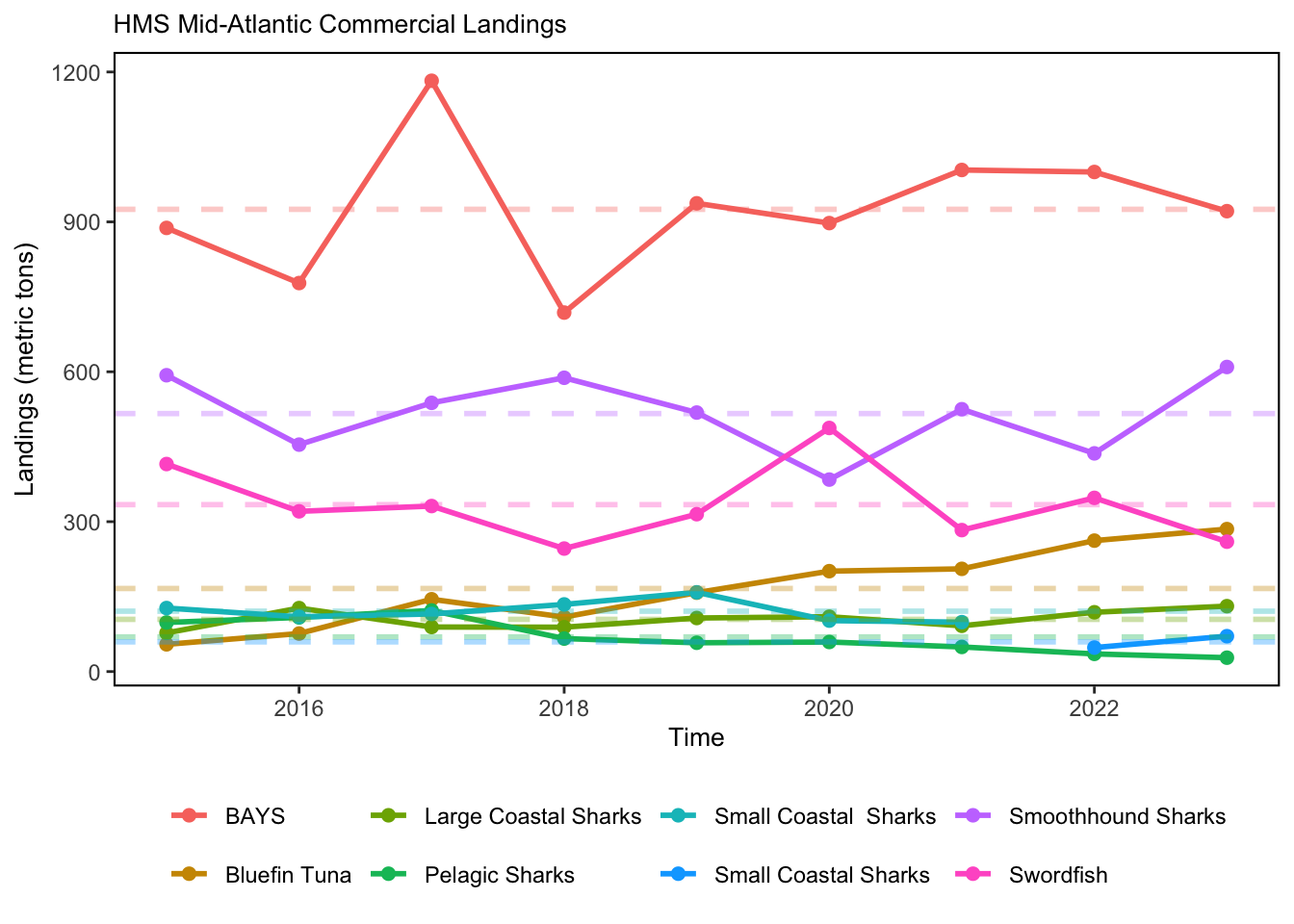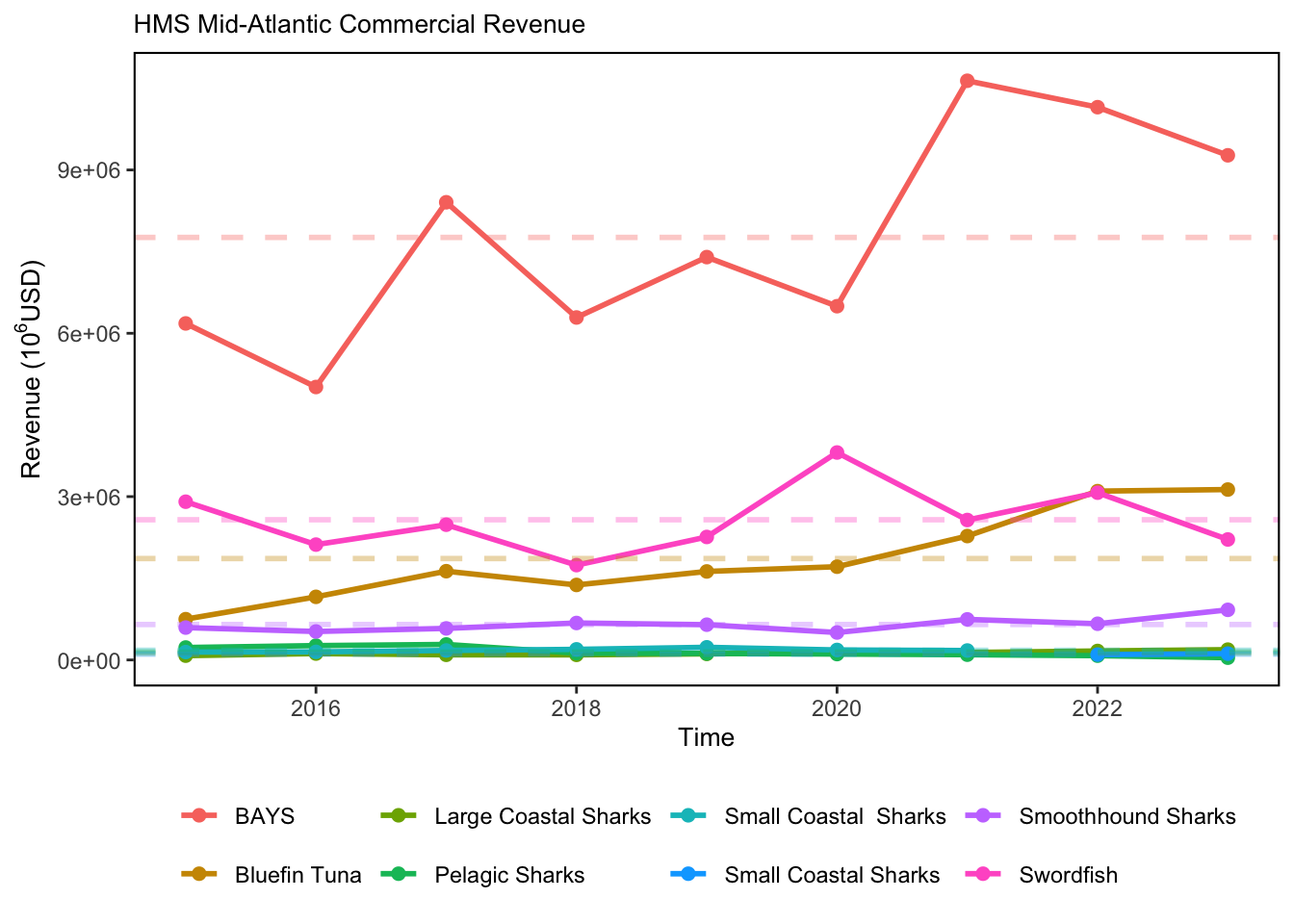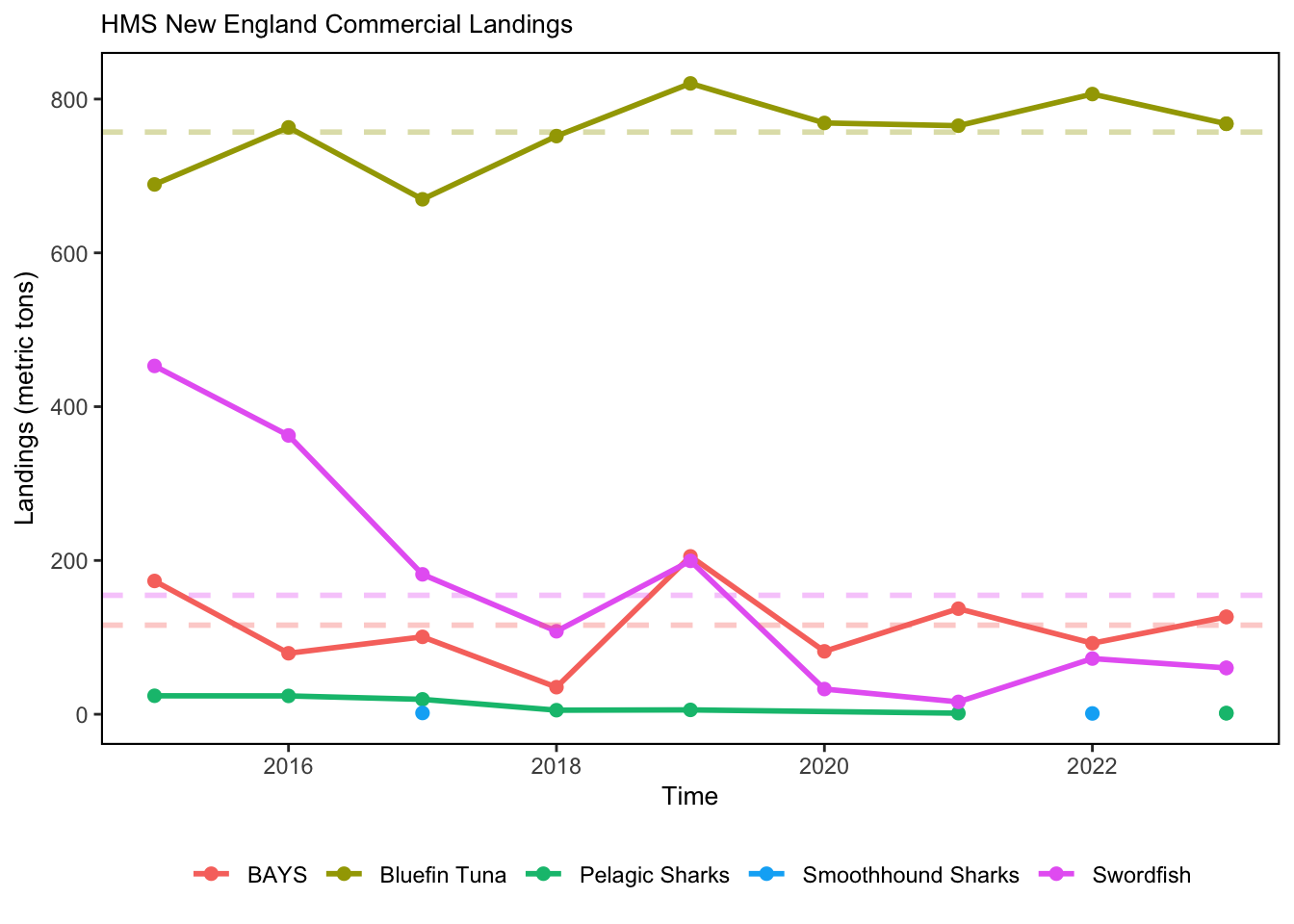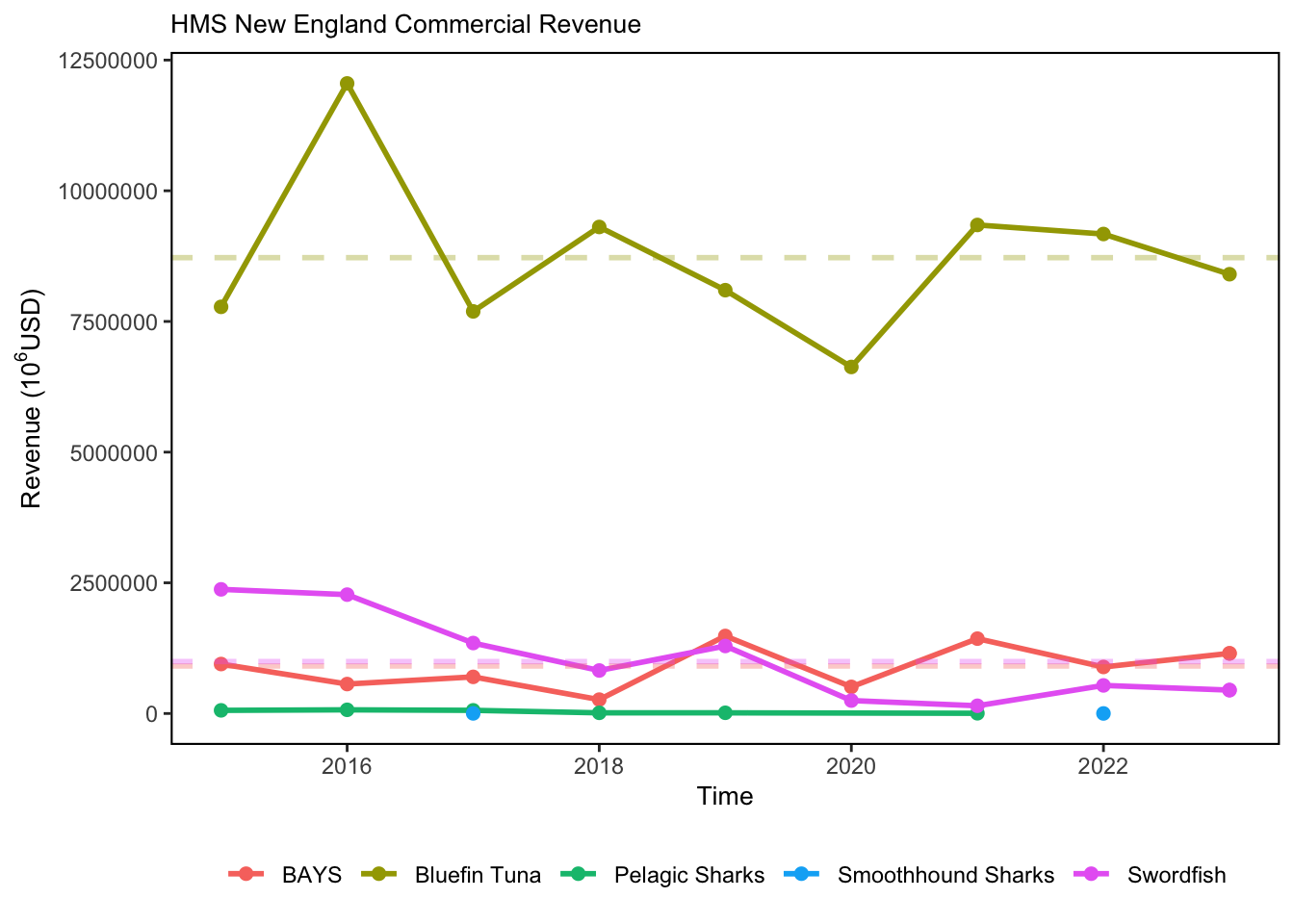SMART Indicator Report: Highly Migratory Species Landings
2 Indicator name
Highly Migratory Species Landings
Includes variable(s): BAYS_HMS Landings, BAYS_HMS Revenue, Bluefin Tuna_HMS Landings, Bluefin Tuna_HMS Revenue, Large Coastal Sharks_HMS Landings, Large Coastal Sharks_HMS Revenue, Pelagic Sharks_HMS Landings, Pelagic Sharks_HMS Revenue, Small Coastal Sharks_HMS Landings, Small Coastal Sharks_HMS Revenue, Small Coastal Sharks_HMS Landings, Small Coastal Sharks_HMS Revenue, Smoothhound Sharks_HMS Landings, Smoothhound Sharks_HMS Revenue, Swordfish_HMS Landings, Swordfish_HMS Revenue
3 Indicator brief description
Aggregated Atlantic HMS landings data prepared for the Fisheries of the United States (FUS) report, spanning 2015-2023.
5 Indicator documentation
5.1 Are indicators available for others to use (data downloadable)?
## Yes5.1.1 Where can indicators be found?
## Data: https://noaa-edab.github.io/ecodata/index.html
## Description: https://noaa-edab.github.io/catalog/hms_landings.html
## Technical documentation: https://noaa-edab.github.io/tech-doc/hms_landings.html5.1.2 How often are they updated? Are future updates likely?
[need sequential look at datasets for update frequency. Future requires judgement]
5.1.3 Who is the contact?
Jennifer Cudney (jennifer.cudney@noaa.gov)
5.2 Gather indicator statistics
5.2.2 Length of time series, start and end date, periodicity
General overview: Annual
Indicator specifics:
Indicator | EPU | StartYear | EndYear | NumYears | MissingYears |
|---|---|---|---|---|---|
BAYS_HMS Landings | MAB | 2015 | 2023 | 9 | 0 |
BAYS_HMS Landings | NE | 2015 | 2023 | 9 | 0 |
BAYS_HMS Revenue | MAB | 2015 | 2023 | 9 | 0 |
BAYS_HMS Revenue | NE | 2015 | 2023 | 9 | 0 |
Bluefin Tuna_HMS Landings | MAB | 2015 | 2023 | 9 | 0 |
Bluefin Tuna_HMS Landings | NE | 2015 | 2023 | 9 | 0 |
Bluefin Tuna_HMS Revenue | MAB | 2015 | 2023 | 9 | 0 |
Bluefin Tuna_HMS Revenue | NE | 2015 | 2023 | 9 | 0 |
Large Coastal Sharks_HMS Landings | MAB | 2015 | 2023 | 9 | 0 |
Large Coastal Sharks_HMS Revenue | MAB | 2015 | 2023 | 9 | 0 |
Pelagic Sharks_HMS Landings | MAB | 2015 | 2023 | 9 | 0 |
Pelagic Sharks_HMS Landings | NE | 2015 | 2023 | 7 | 2 |
Pelagic Sharks_HMS Revenue | MAB | 2015 | 2023 | 9 | 0 |
Pelagic Sharks_HMS Revenue | NE | 2015 | 2021 | 6 | 1 |
Small Coastal Sharks_HMS Landings | MAB | 2015 | 2021 | 7 | 0 |
Small Coastal Sharks_HMS Revenue | MAB | 2015 | 2021 | 7 | 0 |
Small Coastal Sharks_HMS Landings | MAB | 2022 | 2023 | 2 | 0 |
Small Coastal Sharks_HMS Revenue | MAB | 2022 | 2023 | 2 | 0 |
Smoothhound Sharks_HMS Landings | MAB | 2015 | 2023 | 9 | 0 |
Smoothhound Sharks_HMS Landings | NE | 2017 | 2022 | 2 | 4 |
Smoothhound Sharks_HMS Revenue | MAB | 2015 | 2023 | 9 | 0 |
Smoothhound Sharks_HMS Revenue | NE | 2017 | 2022 | 2 | 4 |
Swordfish_HMS Landings | MAB | 2015 | 2023 | 9 | 0 |
Swordfish_HMS Landings | NE | 2015 | 2023 | 9 | 0 |
Swordfish_HMS Revenue | MAB | 2015 | 2023 | 9 | 0 |
Swordfish_HMS Revenue | NE | 2015 | 2023 | 9 | 0 |
5.2.3 Spatial location, scale and extent
General overview: Regionally by EPU
Indicator specifics:
Indicator | EPU |
|---|---|
BAYS_HMS Landings | MAB |
BAYS_HMS Landings | NE |
BAYS_HMS Revenue | MAB |
BAYS_HMS Revenue | NE |
Bluefin Tuna_HMS Landings | MAB |
Bluefin Tuna_HMS Landings | NE |
Bluefin Tuna_HMS Revenue | MAB |
Bluefin Tuna_HMS Revenue | NE |
Large Coastal Sharks_HMS Landings | MAB |
Large Coastal Sharks_HMS Revenue | MAB |
Pelagic Sharks_HMS Landings | MAB |
Pelagic Sharks_HMS Landings | NE |
Pelagic Sharks_HMS Revenue | MAB |
Pelagic Sharks_HMS Revenue | NE |
Small Coastal Sharks_HMS Landings | MAB |
Small Coastal Sharks_HMS Revenue | MAB |
Small Coastal Sharks_HMS Landings | MAB |
Small Coastal Sharks_HMS Revenue | MAB |
Smoothhound Sharks_HMS Landings | MAB |
Smoothhound Sharks_HMS Landings | NE |
Smoothhound Sharks_HMS Revenue | MAB |
Smoothhound Sharks_HMS Revenue | NE |
Swordfish_HMS Landings | MAB |
Swordfish_HMS Landings | NE |
Swordfish_HMS Revenue | MAB |
Swordfish_HMS Revenue | NE |
5.3 Are methods clearly documented to obtain source data and calculate indicators?
## Yes5.3.1 Can the indicator be calculated from current documentation?
[Build link to Tech-doc, look for current and previous methods]
5.4 Are indicator underlying source data linked or easy to find?
[Build link to Tech-doc, look for source, may require judgements]
5.4.1 Where are source data stored?
[Build link to Tech-doc, look for source, may require judgement]
6 Indicator analysis/testing or history of use
6.1 What decision or advice processes are the indicators currently used in?
This indicator provides a comprehensive summary of commercial landings information for HMS fisheries that target or retain tunas, swordfish, and sharks. These data can be evaluated independently, and can also be included in overall estimates of commercial fisheries landings in the northeast region.
6.2 What implications of the indicators are currently listed?
HMS landings data are summarized and presented in the annual HMS Stock Assessment and Fishery Evaluation (SAFE) report. In 2021 the International Commission for the Conservation of Atlantic Tunas (ICCAT) finalized recommendations for a two-year retention ban for shortfin mako (ICCAT Rec. 21-09), which will also affect total overall landings of pelagic sharks in coming years.
6.3 Do target, limit, or threshold values already exist for the indicator?
[Fill by hand; if not in key results or implications, likely does not exist]
6.4 Have the indicators been tested to ensure they respond proportionally to a change in the underlying process?
[Fill by hand; if not in introduction, key results, or implications, likely not tested]




7 Comments
[Fill below by hand once above data complete]
7.1 Additional potential links to management in addition to uses listed above
7.2 What additional work would be needed for the Council to use the indicator?
7.3 What issues are caused if there is a gap or delay in data underlying the indicator